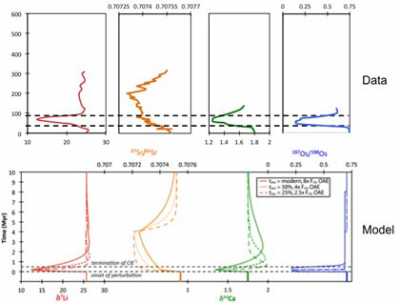Quantifying rates and mechanisms of weathering
The modern Earth provides a natural laboratory to understand the controls over chemical weathering and hence CO2 withdrawal. 80% of the removal of CO2 from the atmosphere occurs through the chemical weathering of the land and rocks that make up our continents, but we do not fully understand how this process is controlled. Comprehending this is important, so that we can constrain both present and past changes to the climate system. For example, understanding the effects of temperature, climate and vegetation is important for determining global distributions of weathering and its effect on climate and water chemistry.
Two possible processes operate: 1) temperature and 2) supply of fresh material.
Temperature would provide a climate-stabilising feedback process, because as CO2 levels and temperature rise, weathering increases, removing CO2, and allowing the climate to cool. If weathering does prove to be temperature-controlled, it could be the key to Earth's natural ability to maintain a climate conducive to life. However, for weathering to occur, fresh material must be available, which could mean that temperature is merely a secondary control, and supply by physical erosion (e.g. from glaciation or mountain building) is the main controlling process.
 |
| Figure 1. Schematic of the two possible controls of weathering on climate |
This is disputed, and current questions include whether, for example, glaciated, cold, terrains with high physical erosion are more influential on global processes than hot, tropical, terrains. This is also potentially important for methods to artificially remove and sequester CO2: if weathering can be deliberately enhanced (for example, by grinding of rock material), we need to know where on Earth it could be most efficiently implemented.
PALAEO-WEATHERING
Evidence of the consequences of current and future climate change can only come from looking at periods in Earth history when climate has also changed rapidly. In addition, it is critical to determine the process that has allowed climatic conditions on Earth so amenable to life to exist for billions of years.
The Cenomanian-Turonian Oceanic Anoxic Event (OAE 2) is a large perturbation to the carbon cycle in the Cretaceous, which was linked to significant global warming, and a large mass extinction. Analyses of lithium isotopes across this interval show that this event was triggered by high levels of CO2 emissions (~10Gt/year, close to current emissions) from volcanic activity which led to rapid global warming. As temperatures increased, so did the rate of weathering; in fact, within 300,000 years, weathering had removed roughly half of the CO2 from the atmosphere, allowing the oceans and climate to recover much more quickly than was previously thought possible (Pogge von Strandmann et al., 2013, Nature Geoscience). The Li isotope proxy is also being studied for how diagenetic processes may affect palaeo-signals (Ullmann et al., 2013, GCA).
 |
| Figure 2. Top panel: isotopic data (Li: red, Sr: orange, Ca: green, Os: blue) showing the perturbations observed across OAE2 (represented by the dashed black lines). The bottom panel shows model results for enhanced weathering of basalt for 200 kyrs (Pogge von Strandmann et al., 2013, Nature Geoscience.) |
 Close
Close


